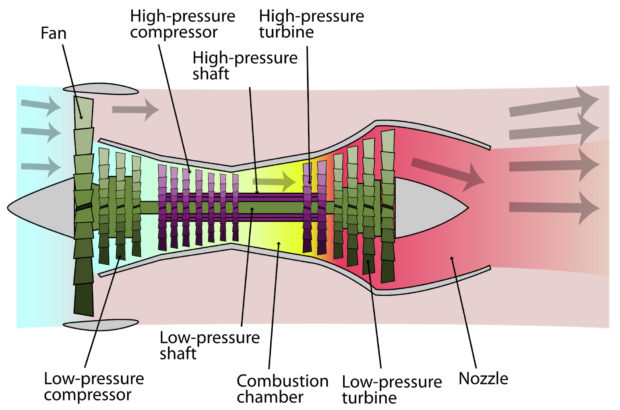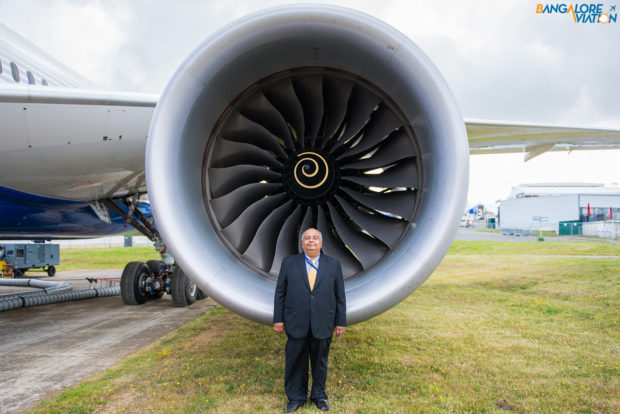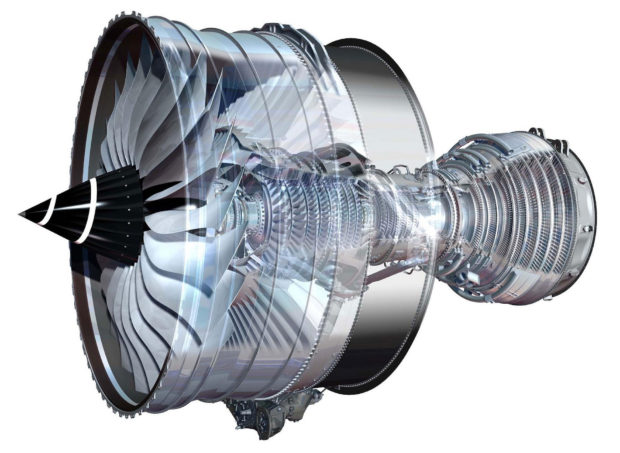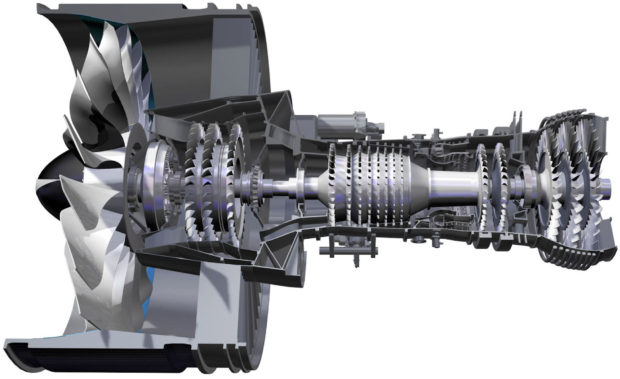The on-going issues of the Pratt & Whitney PurePower PW1100 G-JM Geared Turbo-Fan (GTF) engine fitted on the Airbus A320neo (New Engine Option) are well known. Original launch customer Qatar Airways has refused to take delivery of the new variant citing these problems. The GTF engine has been inducted in to the fleets of Indian carriers, first with market leader IndiGo and then with Go Air.
We try to explain some details of the GTF engine, its benefits, the on-going issues, and the potential impact on fleet and network operations.
Editor’s note: Responses from Pratt and Whitney, Airbus, and IndiGo are embedded within this externally written analysis.
The PW1100 G-JM Geared Turbo Fan
The Airbus A320neo has two engine options. The GTF engine from Pratt and Whitney (PW) and the LEAP from CFM. The GTF engine is named PW1100 G-JM. The name itself is interesting and is an acronym as below:
- PW – Pratt & Whitney
- 1 – Engine model
- 1 – A320 Family airframe
- G – geared turbofan
- J – Japanese Aero Engines Corporation (JAAEC)
- M – Moteren-und-Turbinen-Union Aero Engines
What is a jet engine

Overall, a jet engine functions on the principles of propulsion where air is taken into the engine via a turbine fan in the front. The air is then compressed and passed on to a combustion chamber (the turbine) where it is further compressed and ignited with jet-fuel (a highly refined form of kerosene). This air-fuel mixture expands rapidly and is shot out of the exhaust nozzle at the back of the engine providing forward thrust for the aircraft, and spinning the front compressor blades via a connected shaft, which in turn compresses the inlet air, and the cycle becomes self-sustaining.
High by-pass engines
In later years, high by-pass ratio turbo-fan engines were developed to improve fuel economy. A small part of the air passes through the jet engine core, and a large part via the front fan blades similar to a traditional propeller but at higher speed i.e. a turbo fan, thus “by-passing” the engine core. The bypass ratio measures the flow that enters the engine and via the combustion chamber to the air that bypasses the engine core. A higher ratio indicates higher efficiency. The diameter of the fan at the front of the engine has become larger over the years.


The Geared Turbo Fan
In most direct drive engines the turbine, where the fuel burns, and the compressor, at the front, operate at the same RPMs due to a common shaft. This produces inefficiencies like higher noise, and requires additional stages for optimal operation of each section of the engine.

The GTF engine, has a set of gears just behind the front compressor fan, which allows the front compressor and low pressure section to spin at a slower speed than the high pressure compressor and turbine stages towards the rear, which normally spin at higher speeds. This independence of speeds allows the GTF engine to give higher efficiency, a lower number of stages (thus reducing overall maintenance costs), and a much quieter engine. The GTF engine has a bypass ratio of 12:1 compared to competitor CFM’s 11:1 on the LEAP-1A for the A320neo and 9:1 on the LEAP-1B for the Boeing 737 MAX. Furthermore the gear is not life limited unlike other parts of the engine.
This 2011 comparison between the GTF and LEAP engines by Ernst Arvai at Airinsight is a good read for those interested in more details.
Video of how the Geared Turbo Fan engine works
Some technical specifications on the GTF engine:
- The front fan has a 20 blade count
- The low pressure spool has three low pressure booster compressor stages + three exhaust turbine stages (3+3)
- The high pressure spool has eight compressor stages and two high pressure turbines (8+2).
- There are 18 fuel nozzles and two ignite plugs.
Initial issues with the GTF engines
The initial issues with the GTF engine, now all resolved, related to:
- Start times – engines taking up to three minutes to start after a shut-down
- Spurious cockpit warning messages via the Full Authority Digital Engine Control (FADEC)
- Hydraulic fluid temperatures
Operators were given the aircraft with software upgrades planned, to address FADEC issue, and network schedules tweaked, to address start times. The hydraulic fluid temperature issue was also addressed with engine parameter tweaks and industry sources indicate that the A320neos in operations are delivering good operational performance and the GTF engines are quieter.
These issues and resolution efforts, have led to delivery delays of the Airbus A320neo. Original launch customer Qatar Airways placed the responsibility of optimum operations on airframer Airbus and refused to take delivery, awaiting assurances and resolution. The two India operators Indigo and Go Air, too faced delays. Indigo received its first A320neo in March 2016 and Go Air received their first NEO in June, both deliveries commenced about three months late.
Ongoing issues with the GTF engine
Industry sources indicate despite the initial resolution, additional technical challenges still remain with the PW1100 GTF engine on the A320neo. Specifically with:
- Aluminium-titanium fan blades – including production constraints
- Combustion chamber issues – including replacement/re-design of components
- Valve replacements and engine oil indications
Airbus has indicated to its buyers (the airlines) that they have enough engines to fit on all remaining aircraft scheduled for delivery in 2016. In 2016, Airbus delivered 68 NEOs. They plan to address the delay by sharply increasing production in 2017. However, it remains to be seen whether Pratt can deliver to the scaled up plan.
Editor’s note: Airbus spokesperson responded to our queries saying “…we always said that in 2016 NEO deliveries would be backloaded. We delivered 68 NEO in total in 2016. In the results press conference yesterday Fabrice Bregier, President Airbus Commercial Aircraft said we’d triple the NEO deliveries in 2017”
Premature engine changes
Industry sources indicate, some A320neos have been forced to make engine changes due to the ongoing engine issues as detailed above. It is understood that Indigo has made 12 to 15 engine changes while Go Air has made three to five engine changes. This raises concerns on the on-going engine modifications and requires greater transparency in to the reasons why these engine changes were / are required.
Customers happy despite issues
The two current operators of the A320neo in India, Indigo and Go Air, appear to have had successful inductions of the PW1100G-JM GTF engine. Reports indicate that the fuel consumption reduction is coming to around 15%, and in some cases higher, due to very new engines. In the over-taxed fuel, and ultra-competitive ecosystem of India, the fuel savings are a godsend. The GTF engine is also a much quieter engine and A320neo passengers are experiencing the benefits of a quieter cabin.
Editor’s note: IndiGo’s President and Whole Time Director, Aditya Ghosh responded to our queries saying “…yes, the engine removals have been higher than our expectations. But I must say that Pratt & Whitney is doing a spectacular job of supporting us. And of course the fuel burn continues to hit the target fuel savings”
Contingency plans at IndiGo and Go Air
The delivery delays are impacting the plans of both Indigo and Go Air to increase their fleets and capture an increased share of the fast growing Indian market. The two airlines are making up for the shortfall by inducting additional A320ceo (classic). Indigo has inducted dry lease aircraft while Go Air has gone with wet leases (crew inclusive) through Small Planet Airlines. More A320ceo inductions are likely at both carriers although the market has few aircraft to offer on a short-term basis.
Given that the delays will continue into 2017 in part, it is likely that additional dry leases will be the short term stop-gap measure adopted.
Outlook
Tata-SIA Vistara and national carrier Air India, both future NEO operators have opted for the CFM LEAP 1A engine, possibly expecting shorter delays, though Air India just announced a delivery delay of one month in the delivery of its first two A320neos due to “engine issues”.
Pratt & Whitney will resolve issues with this engine, sooner, rather than later. In the short terms airlines will continue to their tweaks and work-arounds.
As fuel prices trend upwards and are likely to settle in the $60 – $65 range (stay tuned for Bangalore Aviations forecasts coming soon), the 15% improved fuel burn of the GTF engines will provide significant competitive advantage for operators in terms of a lower CASK [cost per available seat kilometre]. Currently this advantage is not felt to its full extent given the relative small percentage of the NEOs in the fleets of the operators.
Given the large orders by both IndiGo and Go Air, on a long term, the A320neo powered by the GTF engine, will become the core of the Indian airline market fleet in the years to come.
Editor’s note: Pratt & Whitney spokesperson responded to our queries. We have reproduced the statement in its entirety. The video on the working of the GTF engine is embedded earlier in the analysis.
Pratt & Whitney’s Geared Turbofan Engines are transforming aviation with the most fuel efficient and most sustainable engine in its class. We continue to see great performance from the Geared Turbofan Engine. The in-service GTF engine fleet is meeting the commitments we laid out when we announced the program in terms of fuel burn, emissions and noise reduction. The GTF engine is reducing fuel burn by 16%, regulated emissions by 50% and the noise footprint by 75%. The noise reductions and efficiency savings are expected to transform the future of aviation, to the benefit of passengers, airlines, and airports and their neighbors.
Transforming Aviation: The GTF engine’s first of its kind, hybrid-metallic fan blade is an example of Pratt & Whitney’s advanced technology that has a helped the engine to meet or exceed every performance specification – 16% fuel burn, 50% emissions, and a 75% reduction in noise footprint. The following animation shows how the GTF works while highlighting how the engine’s different rock-solid architecture leads to the mentioned benefits.
Customer Testimonial
In its first year of service the PurePower engine family has powered aircraft for 13 operators on Airbus A320neos and Bombardier C Series aircraft with greater than 99 percent reliability. Pratt & Whitney is providing more than just an engine; we’re transforming aviation.
Operators love the engine. Here are just a few testimonials:
- “Two things stood out immediately,” said Jyri Strandman, vice president of flight operations at Spirit Airlines, who piloted Spirit Airlines’ first Airbus A320neo on the ferry flight from Germany to Florida. “Number one was that the engines are extremely quiet. Secondly, when we landed, we noticed we had a whole lot more fuel than we expected to have.”
- Volaris CEO Enrique Beltranena used a good part of his speech during the Volaris A320neo delivery ceremony to promote Pratt & Whitney and the PurePower Geared Turbofan engine. He spoke about the fuel burn savings, reduced noise, reduced emissions, bypass ratio performance and thrust capability. He was very pleased with the technology.
- The Viva Aerobus A320neo ferry flight to Monterrey, Mexico from Keflavik, Iceland, was 9 hours and 32 minutes, becoming the longest A320neo flight. The A320neo also experienced an 18% better fuel burn [than the A320ceo]. –Viva Aerobus
We are working closely with our customers to minimize any impact to their operations. We value their partnership and we will continue to support them in their industry growth with our engine technology. We are aligned and working closely with all our customers on aircraft delivery schedules. Even though it is still early in the process, our customers are seeing the benefits with the reduction in fuel burn and noise.
GTF Engine Facts:
- The GTF engine is validated for five different advanced biofuels, and Pratt & Whitney is co-leading the process of approving more.
- The GTF engine’s reduction in emissions will allow airlines to avoid 160 million tons of CO2 emissions through 2025.
- The GTF engine will cut carbon emissions by more than 3,600 metric tons every year; equivalent to taking 3 million cars off the road.
- Approximately 500,000 fewer people in airport surrounding communities will hear a GTF engine-powered airplane takeoff compared to a conventional aircraft at the same airport. This is due to the 75% noise reduction of the GTF engines.
- The GTF engine is in revenue service on four continents.
- The GTF engine’s fuel efficiency will save airlines about 15 billion gallons of fuel from now until 2025.
- The GTF engine has more than 80 customers, for both announced and unannounced firm and option orders, from more than 30 countries.
We are in the early phase of an engine program that will span more than 30 years into the future. We are working closely with all our customers and keeping everyone apprised of the progress being made. Pratt & Whitney is proud of the years of hard work leading up to this moment and we will continue to work even harder to make sure we meet customer expectations.
Please share your views and thoughts via the comments.
 Bangalore Aviation News, Reviews, Analysis and opinions of Indian Aviation
Bangalore Aviation News, Reviews, Analysis and opinions of Indian Aviation




4 comments
Pingback: DGCA brief details issues with the PW1100 GTF engine on the A320neo - Bangalore Aviation
Pingback: Analysis: IndiGo first quarter FY2018 results and fleet, plans, and strategy - Bangalore Aviation
Pingback: Impact of the new Pratt & Whitney GTF engine issues on IndiGo and Go Air - Bangalore Aviation
Pingback: IndiGo’s soaring GTF engine problems – Bangalore Aviation